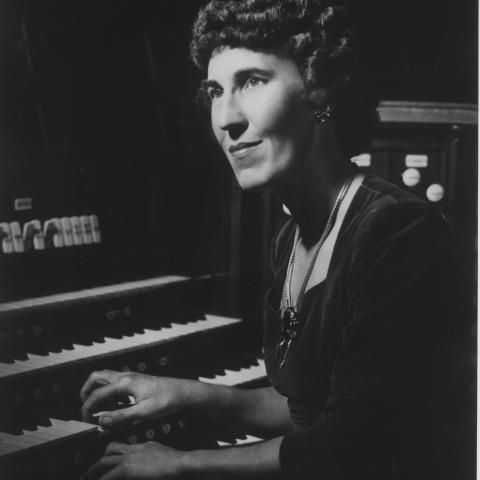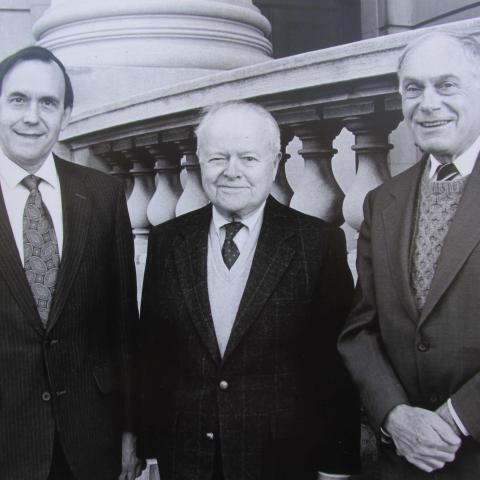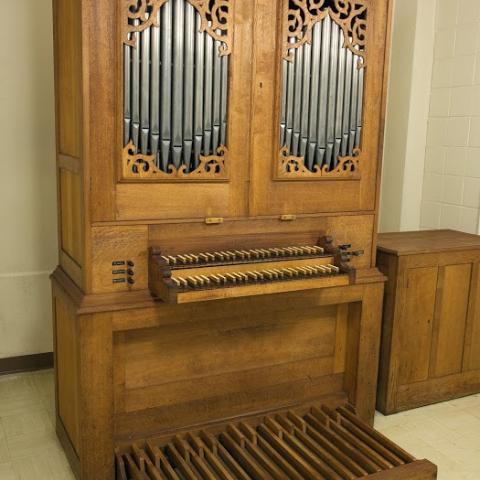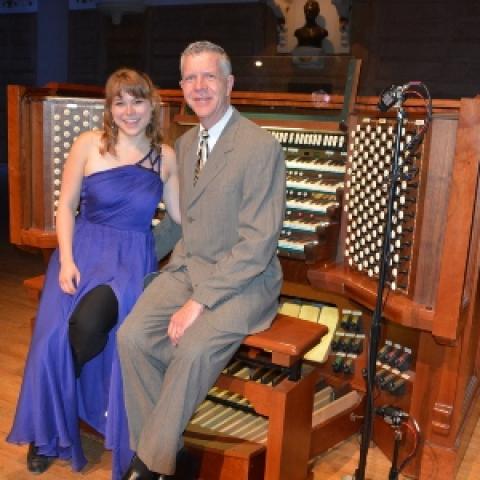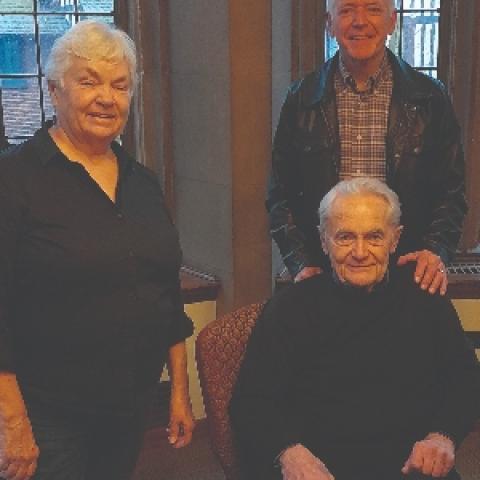
Giving thanks from A to Z
As I near my eighty-first birthday on November 13, I have been thinking nostalgically about the palindromic symmetry of 18 and 81 and wondering how I could write something of interest using those numbers. Searching through many composer biographies, I found only one major figure who was born in 1881 (Béla Bartók) and another who died in that year (Jacques-Nicolas Lemmens), so I decided instead to give thanks to so many friends, mentors, and helpful teachers who have made both the personal and professional experiences not only possible, but most often awesome and exciting. Immediately, although in reversed alphabetical order, the first two are women of great talent and extraordinary teaching abilities who began the template: my first outstanding organ teacher, Mabel Zehner, and the person who kindled my love for the harpsichord, Isolde Ahlgrimm.
In the prelude chapter to my 2006 book Letters from Salzburg, I wrote the story of my childhood insistence on studying piano while my Presbyterian minister father was serving as pastor of a small church in Corsica, Pennsylvania. It took the hiring of a neighbor girl to give me several lessons before my parents gave in and enrolled me in the piano studio of Erma Bowdish in nearby Brookville. In the chapter I continued:
A reed organ at church, a clarinet at school, a move to Crestline in central Ohio where the church had an 1890s Jesse Woodbury pipe organ; a change from clarinet to oboe, continuing piano lessons with my high school music teacher Lucille Pennington—all this dovetailed with a high school career that included a switch to the oboe, participation in orchestra, concert and marching bands as well as choir, many student government positions, three years as class president, and graduation in 1956 as the class valedictorian. Much of the academic success was due to the superb faculty of Crestline High School. I learned so much from two maiden ladies, Elizabeth O’Leary (penmanship and English composition) and Faye Griebling (Latin), the latter going so far as to agree to tutor another student and me in a two-person third-year class, which helped to broaden our foreign language experience since the school did not offer any contemporary European linguistic study.
During that final year in high school, at last in possession of a driver’s license, it became possible for this young musician to study organ with an expert teacher, Mabel Zehner of Ashland College, thirty miles away. Her kind tutelage prepared the young student for admission to Oberlin Conservatory and its large organ department. For two years I worked with a strict, authoritarian teacher, Leo Holden, who required me to develop a solid technique that would serve quite well. I sang in the 180-voice choir of First Church in Oberlin (Congregational), conducted by Oberlin’s director of choral activities, Robert Fountain. I learned much from Oberlin’s distinguished faculty, especially from virtuoso theory teacher Robert Melcher and from Oberlin graduate and visiting professor of music history, Janet Knapp. And, after two years “with Holden,” I requested a change of teachers and finally joined the studio of Fenner Douglass, whose knowledge of historical styles and repertoire and advocacy of mechanical-action organs meshed more nearly with my own interests.
Another hallmark of my life seems to be the good fortune of being at the right place at the right time: perhaps that was why I was so anxious to make my debut that I surprised both mother and father by arriving six weeks ahead of schedule (born on a Sunday morning, I often wonder what my dad’s sermon must have been like that day!). Calvin Hampton and I were the youngest members of the organ department’s 1956 incoming freshman class, and I also wondered if we were so compatible because, had I waited until the later date, we would probably have been born on the same day, December 31.
At any rate eighty-eight members of the music department were informed at the end of that first Oberlin year that we would all be studying for our entire junior year at the Salzburg Mozarteum. No third-year music classes would be offered at the Conservatory during the 1958–1959 academic year. And so it was that letter number 17 from Austria informed my parents:
18 November 1958
This morning I first met Frau Isolde Ahlgrimm, a person who will be, I think, quite important in my musical life [an understatement if ever there was one!]. Frau Ahlgrimm is my new harpsichord teacher, and here, as with Mr. Douglass last summer, I have a teacher in whom I can fully believe and whose musical ideas I can fully respect. She is absolutely fabulous! . . . I had my first lesson from 4 till 5:30 this afternoon, and we are beginning with some very early English music and through this will study English ornamentation, then go on to early German and early French music. Since I have always wanted to study harpsichord [since first hearing Wanda Landowska’s first vinyl recordings that I was permitted to borrow from the Crestline Public Library, generously allowed by my dear friend and supporter, the town librarian Marie Welshon, another major helper in my musical development] . . . I think it a real privilege to have such a good teacher here. She has just been hired, lives in Vienna, and comes here three days a week. She has quite a reputation in Europe, I understand.
A citizen of the world
The Salzburg year was a tremendous success for most of us. But, as I have come to realize, successes do not always please every faction. Despite a student approval rating of more than 90% during the six years of Oberlin’s “Salzburg Program” the faculty in Ohio was not so happy with the student results, and after six seasons they voted to end the program. True, we were probably not as disciplined in our memorizations, and we had less practice time and fewer facilities for practicing, but the wonderful things we learned about music and life completely changed the entire trajectory of many of our future activities. And the sheer joy of making music in rooms where our beloved composers had spent time—Oberlin, at least in the late 1950s, could not quite measure up in that department.
For my senior year back on campus I had the honor of being selected as the “roomer” in the house of Intellectual History Professor Frederick Artz. And it was particularly a good fit because I could get to my church organ job by climbing over the hedge to First Church and its early twentieth-century Skinner pipe organ. Yes, I had been offered the job of organist for Robert Fountain. Little did I know how much this would influence my first two teaching positions! But more of that later.
Most immediately to this saga I received a phone call from Professor Douglass one fall morning at church, “Would you like to audition for Eugene Selhorst from the Eastman School of Music, an institution that was about to launch a doctoral program in church music?” Of course, I said yes, especially since my father had made it clear that, after their generous support for my Oberlin years I would have to finance the rest of my education myself. Long story made short, I, along with two other Oberlin students, received the full tuition and stipend grants financed by the United States government to help develop new academic programs. Shortly after looking at a New York City possibility, Union Theological Seminary’s well-known sacred music degrees, and learning that scholarships were tiny and not easy to come by, my next three years might not only be paid for, but there it could be that money would not be a problem.
And so it was that after a glorious, if frantic, senior year on the Ohio campus I joined the wonderful ambiance of the Eastman School, which offered an additional waiver of tuition fees since I was the graduate assistant for the head of the new Master of Music/Doctor of Musical Arts church music program, M. Alfred Bichsel, a Missouri Synod Lutheran pastor, choral conductor, and linguist of exceptional intellect and extreme kindness. So followed my single year to the Master of Music with a thesis recital of works by Sweelinck, and, at Dr. Bichsel’s suggestion, the project that became my calling card to so many venues for recitals and lectures: the first-ever book-length biography of the German composer Hugo Distler, a study even mentioned in William Austin’s Norton History tome Music in the 20th Century, even before my work was published by Concordia Publishing House.
With extra resources galore, I was able to keep my promise to my parents and take them to “my” Europe for their wedding anniversary, particularly since I needed to do onsite research about my thesis subject and even got to interview the composer’s widow Waltraut Distler. Back in Germany I was able to go to Lübeck to visit the Distler Archive, and my parents were able to meet, in Passau, the builder of my first harpsichord—Kurt Sperrhake, whose small two-manual harpsichord arrived during my senior year at Oberlin (via the St. Lawrence Seaway) and was promptly ensconced in the side gallery of First Church during that year (where it was much easier to get to than its snug, just-barely-movable perch in my third floor small room at 20 Sibley Place in Rochester). (I still shudder when I remember my uncle, who helped move the larger major things to the “north land” and who nearly got his neck caught between the wall and a railing as he aided us in moving it to the lofty height.) Needless to say, it did not leave that room until three years (and two degrees) later—and several of my most difficult experiences turned out to be the occasional private harpsichord recital that could accommodate twenty people (if they would stand up and not breathe too deeply).
Especially memorable was just such a program that occurred when Isolde Ahlgrimm was brought to Eastman for other concerts and masterclasses. The music history department was filled with my friends, both faculty and students, and when they asked me whom to bring for Baroque music I was delighted to suggest my wonderful Austrian teacher, who was, that year, spending time at Oberlin as visiting professor. As she was wont to do, Ahlgrimm played the complete Well-Tempered Clavier preludes and fugues—but the most difficult thing for me was trying not to snub anyone who wanted to attend the program, but—it was a very tight and fairly long evening. But what playing . . .
It was at Eastman that I was able to commission my second organ piece (the first one had been a short offertory for my summer church job in Canton, Ohio, during the Oberlin days when I asked Calvin Hampton to compose something for a broadcast service). Since one of my topics in graduate study was Gregorian chant I had developed a program based on the Kyrie fons Bonitatis and was having trouble finding a contemporary work. The very young first-year student Neely Bruce endeared himself to me when he tapped me on the shoulder and asked where Dr. Bitchell’s office might be since he would like to audition for the Sacred Music Choir. When I stopped laughing I told him to be sure to say Bichsel, not Bitchell. Neely became a dear friend and after he left Eastman to return to Tuscaloosa for further study, he surprised the music rack of my Sperrhake with the first example of a newly composed harpsichord work specifically for me, his Nine Variations on an Original Theme—still a gem that I love to play.
Organ study with David Craighead was also a great joy and, even though I had only a Hammond organ to play at the nearby Lutheran Church of the Incarnate Word (a new edifice awaiting its already ordered Walter Holtkamp pipe organ), but even with the electronic instrument I was able to give the first Rochester performances of Distler’s A Little Advent Music and Benjamin Britten’s Rejoice in the Lamb. I was honored when offered an extension of my contract when it came time for graduation and a full-time job.
But the salary was not a living wage, and I was tired of the Arctic winters, so when I was offered a chance to fill a sabbatical leave vacancy at the African-American St. Paul’s College in Lawrenceville, Virginia, I accepted it happily. Those years of the earliest (and sometimes violent) Civil Rights events and the murders of so many great figures marked a most eventful time in our history. I was very happy to be organist and choral director, although once again that meant an electronic organ, but the friendships and the sheer joy of making beautiful music with my young singers continues to provide many happy memories.
And St. Paul’s was not that far from Norfolk, where I had heard that there might be an opening at Norfolk State College, the African-American state school in the city that also had Old Dominion College for the paler folk. And there it was that on my first day at the college I received a call from Lyman Beecher Brooks, the college president. Dr. Brooks was a very good administrator and, as the newest member of the faculty (having been hired to teach organ and start an early music program), I could not turn down his request: “The conductor of the choir has wrenched his back and is not able to rehearse them for the opening convocation. Would you be able to take over the rehearsal later this afternoon?” That was the prelude to some of the happiest times of my teaching career.
The choir was second only to the basketball team for the school, and, to finish my story, at the end of that first rehearsal I said to the choristers, “Take your music with you and come back tomorrow with it memorized.” They were good, but undisciplined, and to make a longer story short, they hit the ball out of its lower bounds and apparently made a hit with the audience. Brooks never gave the choir back to its former conductor and I had five exciting years of touring with them and of planning wonderful events including opportunities for them to sing at Oberlin, Wagner College, Westminster Choir College, churches in Washington D.C., etc. In my final year at NSC we took the Penderecki Stabat Mater on tour and Oberlin’s Robert Fountain had only the highest compliments. And it was with this group of stalwart singers and beautiful human beings that we joined Duke Ellington’s sacred music program in the Tidewater city of Portsmouth—one of the highest of high points in my lifetime of joy in making music.
It was during the 1960s decade that I submitted my first offering to The Diapason—a short biography of Hugo Distler. And thus it was in 1969 that Editor Frank Cunkle, who succeeded the magazine’s founder, turned over the harpsichord column to me.
To be continued.

